#small pasque flower
Text
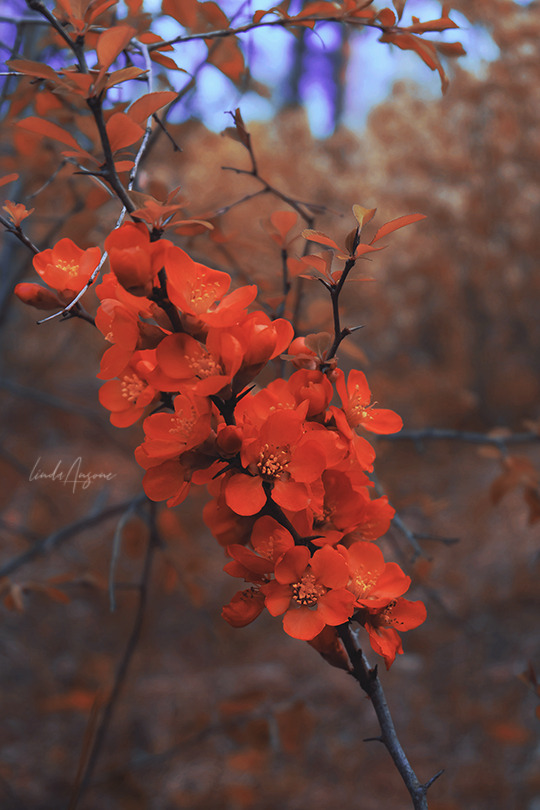

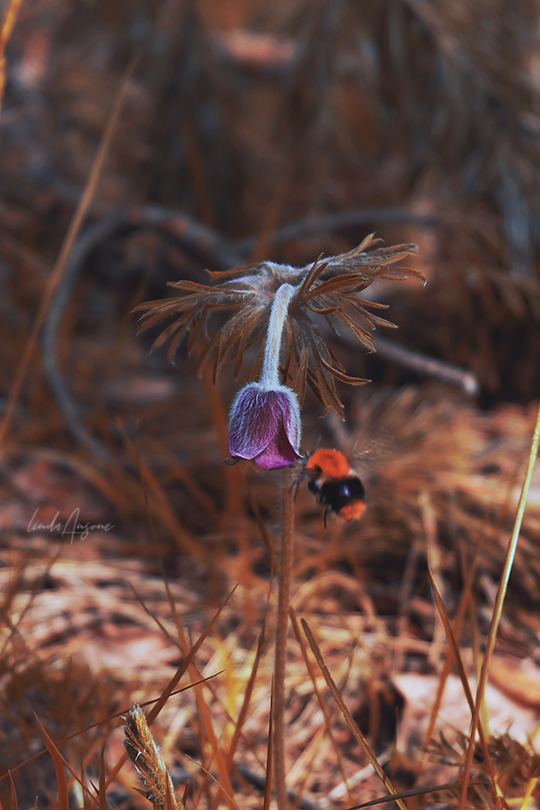

#floral#flowercore#flower photography#flowers#plants#plantcore#wild plants#nature#naturecore#photography#nature photography#original photographers#photographers on tumblr#Pulsatilla pratensis#chaenomeles speciosa japonica#small pasque flower#hybrid quince
476 notes
·
View notes
Text

#small pasque flower#this flower is endangered#so if you see it don't pick it#native to central and eastern Europe#mine#photography#nature#flowers#Pulsatilla pratensis#Anemone pratensis#nature photography
3 notes
·
View notes
Photo

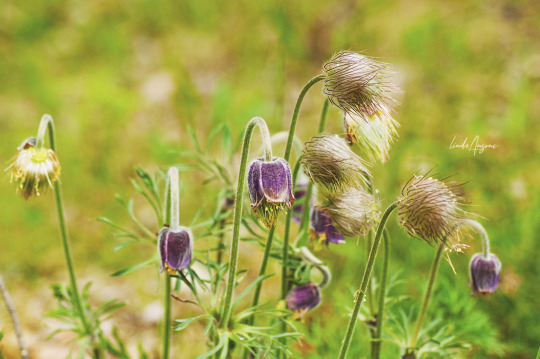
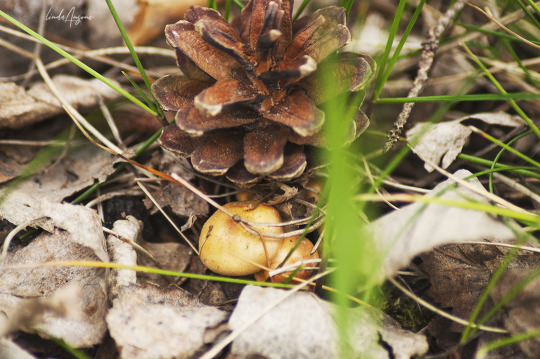





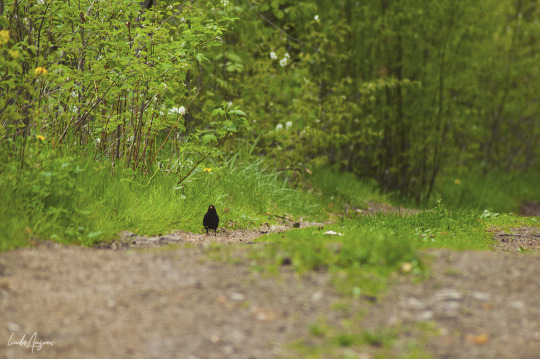

#woods#forest#forestcore#nature#nature photography#common blackbird#turdus merula#pulsatilla pratensis#the small pasque flower#sulphur tuft#hypholoma fasciculare#shadbush#amelanchier#stock dove#columba oenas#veronica persica#persian speedwell#original photographers#photographers on tumblr#latvia
185 notes
·
View notes
Text
#etsy#smallbiz#macro#photography#flower#floral#flower photography#pasque flower#nature#nature photography#shop small
2 notes
·
View notes
Text
"Calming Balance Gel: The Best K-Beauty 3-Second Hydration to Soothe Your Skin During ☀️Summer Heat!"
Introducing the highly renowned "3-Second Hydration" Calming Balance Gel from Incellderm!
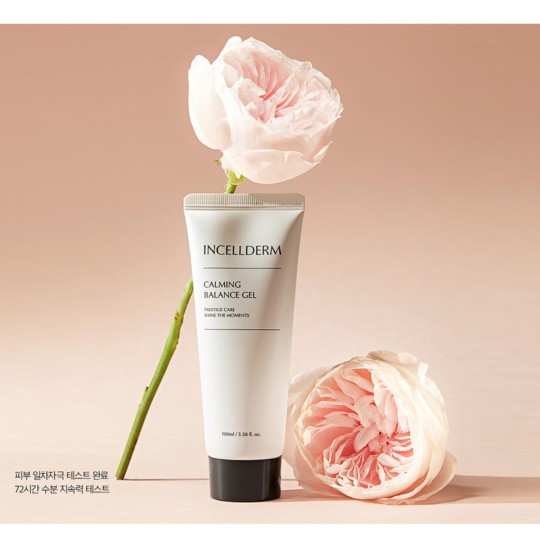

Not only in the United States and Canada but also during the scorching heat and intense UV rays these days, our skin can't breathe properly, sigh.
By using the Calming Balance Gel, you can soothe your precious skin from the harmful effects of UV rays and enjoy the moisture provided by its 7 types of hyaluronic acid that deeply hydrate your skin, even within the layers!
Enriched with seven calming ingredients:
Lavender, Houttuynia Cordata, Chamomile, Green Tea, Zanthoxylum piperitum Berry, Usnea, and Pasque flower!
Infused with the refreshing morning dew, the pure and gentle scent of Damask Rose, which itself can provide healing!
Not only does Calming Balance Gel provide intense hydration for the skin, but its fragrance itself is also a source of healing!
In Korea, this versatile product, known as "Healing Gel," can be used in various ways!
🫧First, even during the intense summer heat when mosquitoes are most active, applying Calming Balance Gel provides soothing relief if you get bitten.
🫧Second, when your skin gets sunburned and feels intensely hot and irritated from exposure to UV rays, the allantoin ingredient works remarkably well in calming and soothing the skin.
🫧Third, it is particularly effective in calming post-cosmetic use reactions. You can find more details about various reactions through the link below!
Moreover, for acne-prone skin, especially during adolescence when the skin is sensitive and delicate, using the Active Clean-Up Powder to create a lather for cleansing, and then applying Calming Balance Gel alone, yields fantastic results!
For the application method of the entire Incellderm skincare line, you can refer to the link below.
🌈 how to use incellderm cosmetics (click)
At Riman, there are two members, Customer and Planner, who receive 5% cashback and Planner receive 10-30% benefits, so joining as a beauty planner is more advantageous!
Please refer to the guide link below and I recommend you to work as a beauty planner.
🌈[must read]How to Join as a Beauty Planner - Step by Step Guide(Click)
#Lavender#Houttuynia Cordata#Chamomile#Green Tea#Zanthoxylum piperitum Berry#Usnea#and Pasque flower#adolescent pimple#Trouble#pimples#small pimples#Ultraviolet rays#burns#mosquito bites#and soothes skin
1 note
·
View note
Text
Bleach Hanakotoba Analysis Part 3 ~ OP16: Scar &
ED31: Saihate

○●○●○●○●○●○●○●○●○●○●○●○●○●○
-> Division 01: Chrysanthemum
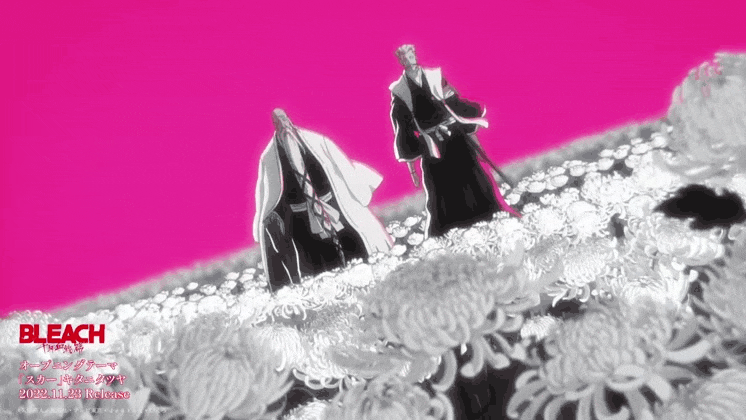

The flower insignia of the 1st division is the chrysanthemum (Chrysanthemum morifolium) which is known as kiku (菊) in Japanese. According to the official Bleach lore, this flower signifies truth and innocence. Its meanings in hanakotoba include nobility, virtuousness, perfection, rejuvenation, longevity and good luck. A sixteen-petalled chrysanthemum is not only one of Japan’s two unofficial national flowers but is also used on Japan’s imperial seal. In Western floriography, Chrysanthemums symbolise cheerfulness, devoted love, loyalty, happiness longevity, joy, trust, optimism, fidelity and friendship. In some cultures, Chrysanthemums—particularly white ones—are only associated with mourning, sympathy and death.
-> Division 02: Pasque flower
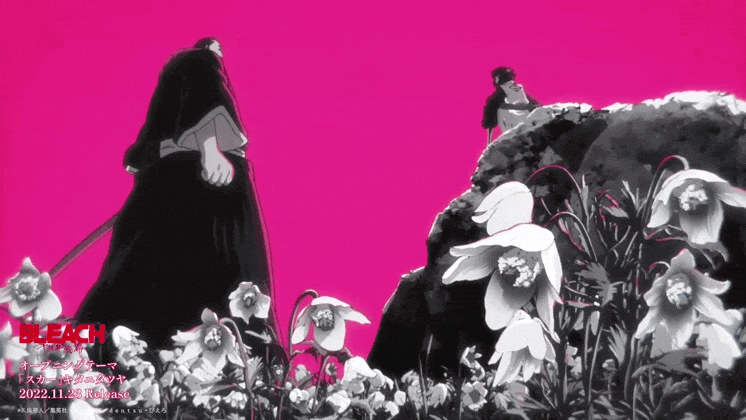
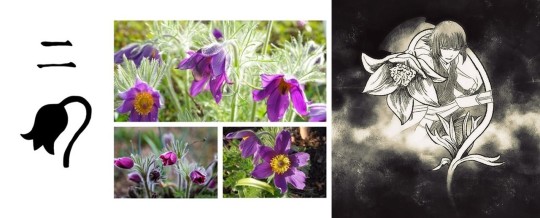
The flower insignia of the 2nd division is the Pasque flower (Pulsatilla) which is also known as the nodding anemone and wind flower. It is called the okinagusa (翁草) in Japan. According to the official Bleach lore, this insignia means “seeking nothing”. Its additional meanings in hanakotoba include “untold love”, “pure heart”, and “love of betrayal”. The downward flower of the Pasque flower is said to have given rise to it symbolising "untold love" and "pure heart" as this is thought to mirror the feelings of a pure girl who is ashamed of her sentiments and finds it difficult to express them. The Pasque flower's symbolic meaning of a "love of betrayal" stems from the fact that after reaching their peak, the flowers that initially bloom face downwards turn upward. In Western floriography, the Pasque flower represents rebirth, renewal, hope, dignity, nobility, grace and the phrase “forsaken in love”.
-> Division 03: Marigold
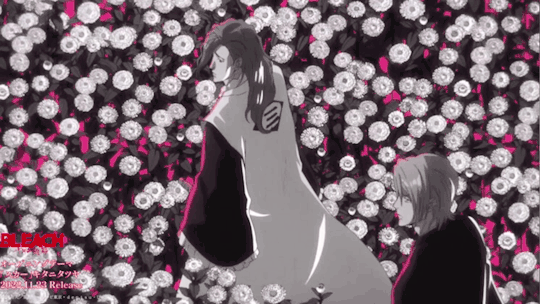

The flower insignia of the 3rd division is the marigold (Tagetes) which is known as the marīgōrudo (マリーゴールド) in Japanese. According to the official Bleach lore, this flower signifies despair. Its meanings in hanakotoba include jealousy, despair and sadness. In Western floriography, they symbolise grief, despair, and jealousy as well as the expression of deep feelings and passion.
-> Division 04: Bellflower
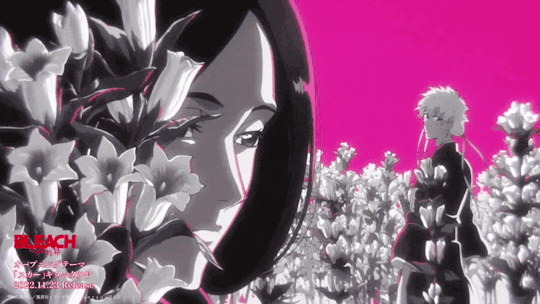

The flower insignia of the 4th division is the bellflower (Campanula) which is known as the berufurawā (ベルフラワー ) and otome kikyo (乙女桔梗 ) in Japan. According to the official Bleach lore, this flower signifies that “those who grieve are loved”. Its meanings in hanakotoba include gratitude, sincerity and pleasant chatter. Bellflowers are a symbol of gratitude, constancy, romance, and support in Western floriography. Additionally, bellflowers can stand for affection, delicacy, humility, and everlasting love. In particular, blue bellflowers are symbolic of peace, healing, openness, tranquility, and friendship—on the other hand, cream bellflowers are symbolic of thoughtfulness, grace, elegance, peace, and hope. Given that a bellflower's shape resembles a church bell, it is believed that the flower's symbolic meanings of gratitude and sincerity originate from church teachings. It is thought that the bellflower's symbolic meaning of pleasant chatter originates from the observation that its flowers which point diagonally upward bloom together giving the impression that the small flowers are merrily conversing with one another.
-> Division 05: Lily of the Valley


The flower insignia of the 5th division is the lily of the valley (Convallaria majalis) which is known as suzuran (鈴蘭) in Japanese. According to the official Bleach lore, this flower represents sacrifice, danger, pure love, humility and sweetness. Its meanings in hanakotoba include purity, humility, sweetness, chastity and finding happiness again. These flowers are symbolic of purity, humility, sweetness, rebirth, good fortune, joy, youth, discretion and a return of happiness in Western floriography. With its lovely, sweet aroma, it's difficult to believe that such a demure-looking flower could be dangerous. It is crucial to highlight, however, that this flower is an extremely toxic plant that, if consumed, can cause severe disease or death. The Lily of the Valley plant contains around 38 distinct cardiac glycosides (cardenolides)—which are a class of organic compounds that increase the output force of the heart and decrease its rate of contractions—that are exceedingly poisonous to both humans and animals. Given its toxicity, it's ironic, that the plant is associated with good fortune, purity, joy, and sweetness.
-> Division 06: Camellia
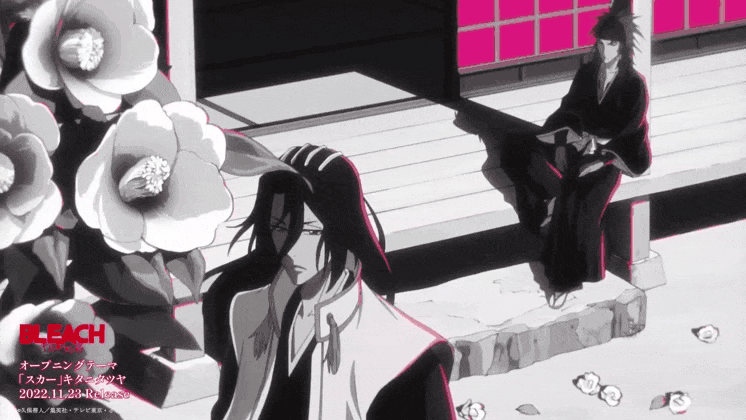
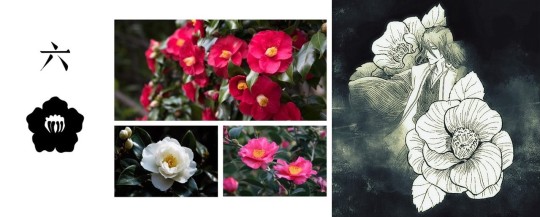
The flower insignia of the 6th division is the Japanese camellia (Camellia japonica) which is known as tsubaki (椿) in Japanese. According to the official Bleach lore, this flower represents “noble reason”. Its meanings in hanakotoba include modest kindness and pride. In Western floriography, camellias have a long-standing symbolic association with romance and devotion. They symbolize strong desire and passion as well as unfaltering love, devotion, affection, refinement, perfection, faithfulness, and admiration. Normally, the petals and calyx separate as a flower dies, but in the case of camellias, the petals and calyx fall together, preserving the entire flower. In recognition of this, camellias are used to represent longevity, perfection, and pure, unreserved, love that never fades. Red camellias are thought to represent romantic love, passion, or desire. Pink camellias convey feelings of longing and gratitude. White camellias are associated with purity, faithfulness, admiration, perfection, and good fortune. On the other hand, white camellias are regarded to bring bad luck in Japan since they are associated with death and mourning.
-> Division 07: Iris


The flower insignia of the 7th division is the iris (Iris japonica) which is known as ayame (菖蒲) in Japanese. According to the official Bleach lore, this flower signifies courage. Its meanings in hanakotoba include glad tidings, loyalty, messages, hope, graciousness as well and kindness of the heart. In Western floriography, they symbolise hope, faith, friendship, wisdom, royalty, valour and messages.
-> Division 08: Crane flower
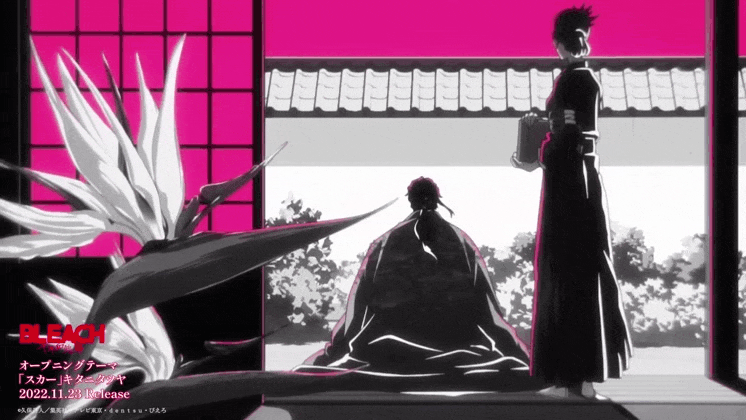
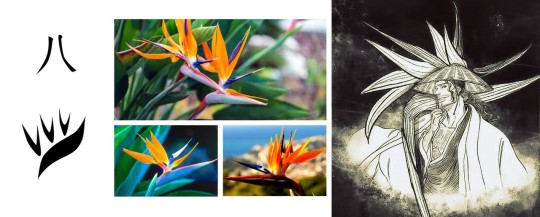
The flower insignia of the 8th division is the Crane flower (Strelitzia) which is also called the Bird of Paradise flower. In Japan, it is known as the Gokurakuchouka (ゴクラクチョウカ ). Its Japanese and English names are derived from the flower’s resemblance to a family of tropical birds native to New Guinea called Paradisaeidae. According to the official Bleach lore, this flower represents “everything that is obtained”. The phrases "date in love" and "pretentious in love" are its hanakotoba meanings. The exotic appearance of the flower, which is compared to a person in love, is considered to be the basis of these connotations. In Western floriography, the crane flower symbolizes magnificence, faithfulness, excellence, success and well as having joy in the face of both challenges and successes alike. Additionally, they also symbolize freedom due to the flower’s resemblance to a bird in flight. The Crane flower is native to South Africa where it holds the meanings of freedom, success, loyalty, thoughtfulness, immortality, love and optimism.
-> Division 09: White poppy
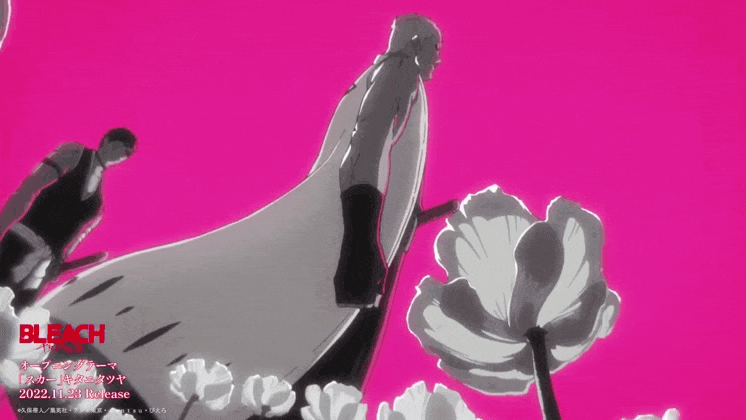
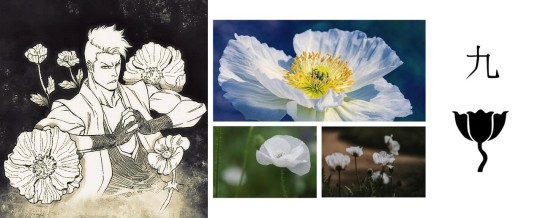
The flower insignia of the 9th division is the white poppy (Arctomecon merriamii) which is known as shiroi popī
(白いポピー) in Japanese. According to the official Bleach lore, this flower symbolizes oblivion. Its meanings in hanakotoba are sleep and oblivion. In Western floriography. White poppies represent sleep and peaceful rest. They are associated with faith and the concept of the soul's eternal life, and they also serve as a symbol of remembrance for deceased loved ones. Given that white flowers are symbolic of purity; white poppies are a symbol of restful sleep, pleasant dreams and renewal.
-> Division 10: Daffodil

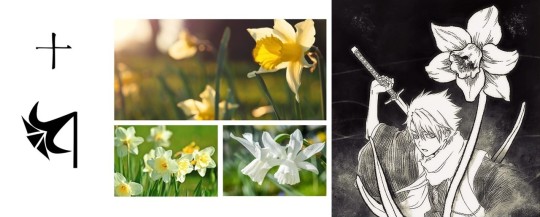
The flower insignia of the 10th division is the daffodil (Narcissus) which is known as suisen (水仙) in Japanese. According to the official Bleach lore, this flower signifies mystery and egoism. Its meanings in hanakotoba include self-love and self-esteem. Yellow daffodils in particular are linked to the phrases "come back to me" and "I want you to love me again." In English floriography, daffodils represent self-love, respect, egoism, and unrequited love. In contrast with the aforementioned negative connotations, daffodils also represent strength, overcoming hardships, and the arrival of success and wealth. White flowers typically symbolize purity—however white daffodils signify a desire for transformation.
-> Division 11: Yarrow
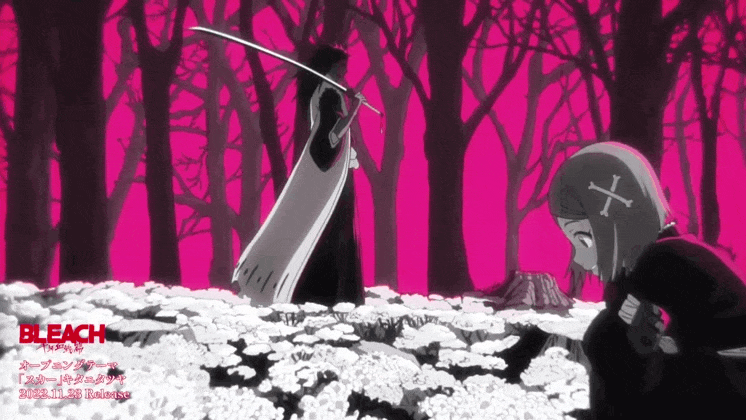

The flower insignia of the 11th division is the yarrow (Achillea alpina) which is known as nokogiri (鋸草) in Japanese. According to the official Bleach lore, this flower signifies fighting. Its additional meanings in hanakotoba include bravery and healing. The yarrow is a symbol of bravery in Western floriography, particularly in times of war, and wearing it is said to bestow courage and protection. The yarrow is also said to represent everlasting love, healing and good health because of its medicinal properties. Its Japanese name, “nokogiri”, translates to “saw grass” and is presumably derived from how the tooth-like shape of a saw’s teeth resembles the plant’s bipinnate/tripinnate leaves.
-> Division 12: Thistle

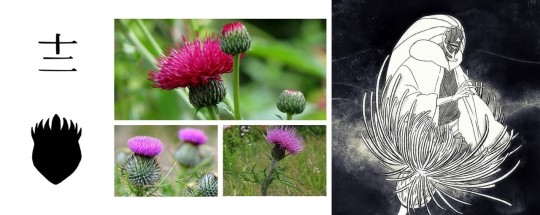
The flower insignia of the 12th division is the thistle (Cirsium spp.) which is known as azami (アザミ) in Japanese. According to the official Bleach lore, this flower signifies vengeance, strictness and independence. Its meanings in hanakotoba are independence, retaliation, sternness and “do not touch”. In western floriography, thistles symbolise austerity, nobility of character, independence and misanthropy. In the Victorian era, the gift of thistle flowers served as a warning against unwanted meddling. These flowers are incorporated in the expression “as prickly as a thistle” which describes someone who is easily enraged, particularly in the face of criticism. As Scotland’s national flower, thistles represent bravery, luck and strength. Thistles are referred to as the "flower of the sun" and the "herb of the witches" in the Basque area of France. It is said that thistles provide protection from evildoers and witchcraft because witches are said to be unable to look directly at the sun.
-> Division 13: Snowdrop


The flower insignia of the 13th division is the snowdrop (Galanthus nivalis) which is known as the sunōdoroppu (スノードロップ) and the matsuyukisou (待雪草) in Japan. According to the official Bleach lore, this flower represents hope. Its meanings in hanakotoba are hope and consolation. In Western floriography, the snowdrop represents purity, rebirth, sympathy and hope. A single snowdrop was seen by the Victorians as a symbol of death and was unlucky to bring into a home. On the other hand, the snowdrop is also associated with rebirth, springtime, and the ability to overcome life's challenges. The snowdrop blooms from mid to late January as winter slowly begins to end thereby reminding us that there is light at the end of the tunnel. It reminds us all that if we put our minds to it, we can achieve great things in life. It also serves as a reminder of change and represents a willingness to grow. Snowdrops are thus often gifted to those trying to move forward from sadness and negativity.
○●○●○●○●○●○●○●○●○●○●○●○●○●○
[If you liked this post, check out part 1 (here) and part 2 (here)... Also, here's the link to my directory of other hanakotoba analysis posts (here)]
[P.S. Here is the final part of my hanakotoba analysis on Bleach. I kept things brief and didn't go into how each flower suits each squad, captain and vice-captain primarily because of time constraints... Also, I doubt anyone wanted to do that much reading lol... I'll happily elaborate and answer any questions in the comments though...]
#tried to keep this brief but ended up rambling lol#bleach#bleach anime#hanakotoba analysis#bleach hanakotoba#bleach florigraphy#hanakotoba#floriography#anime hanakotoba#anime analysis#bleach ed 31#bleach op16#anime openings#anime endings#anime music#anime#bleach tybw#bleach tybw part 1#bleach tybw part 2#bleach tybw anime#tybw#gotei 13#soul society#bleach captain#bleach captains#gotei 13 captains
67 notes
·
View notes
Text

Featuring plants that are happy in high, alpine meadows and craggy mountain sides, alpine plants are small, surprising treasures for the adventurous mountaineer.
This gold foil stamp tape by @amandaherzman features cyclamen, edelweiss, pasque flower, alpine buttercup, moonwort, gentian and primrose.
mush.house/amandaherzman 🌺
#flower#plants#alpine#floral#botany#horticulture#indieartist#indieart#gift#giftideas#supportartists#art#washi#washitape#washiaddict#stationery#washiwednesday#ノートデコ#マステ#indie artist#cute#mushroomy#artists on tumblr#illustration
63 notes
·
View notes
Text

Source: pinterest.com
ℍ𝐚𝓵l נ𝐀 𝔳คĻǤẸ - karukell. Pulsatilla vulgaris. Small pasque flower.
3 notes
·
View notes
Photo

“Yet hear me, friends! We have now to deal with another people, small and feeble when our forefathers first met with them, but now great and overbearing. Strangely enough, they have a mind to till the soil, and the love of possessions is a disease in them. These people have made many rules that the rich may break, but the poor may not! They have a religion in which the poor worship, but the rich will not! They even take tithes of the poor and weak to support the rich and those who rule. They claim this mother of ours, the earth, for their own use, and fence their neighbor away. … If America had been twice the size it is, there still would not have been enough.”
~ Sitting Bull
In his speech at an Indian council at the Powder River in 1877
South Dakota designated the American pasque (Pulsatilla hirsutissima) as the official state flower in 1903.
#by J Marion Brown#naturephotography#macrophotography#pasqueflower#photographers on tumblr#quoteoftheday
49 notes
·
View notes
Text



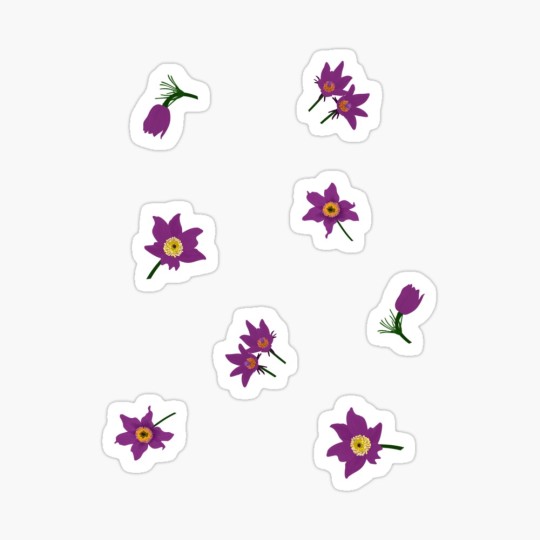


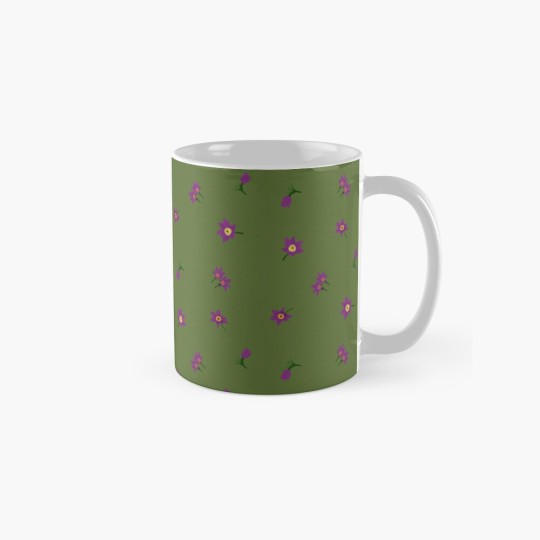


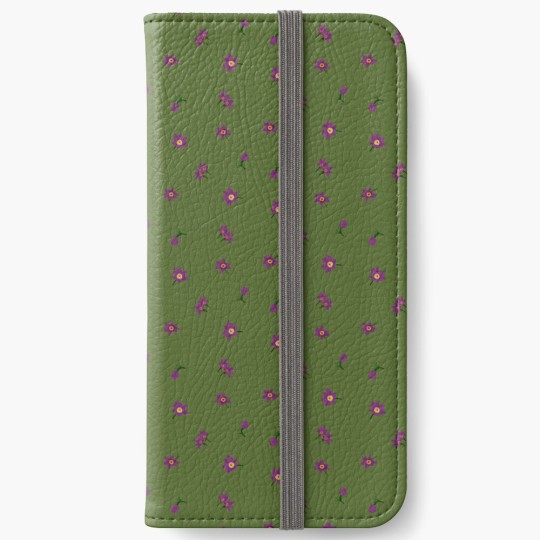
The purple flowered Pasqueflower is named after the Hebrew word for passover – pasakh. Visible across meadows and prairies in the springtime, mostly in Asia, Europe and N. America. AKA wind flower, prairie crocus, Easter flower, meadow anemone.
Thank you for supporting a small business.
To go straight to this design: https://www.redbubble.com/.../Pasque.../140918666.A9G4R
To see my other designs: TheScraggyBeard.redbubble.com
#thescraggybeard#scraggybeard#pasqueflower#pulsatilla#purple#flowers#aesthetic#spring#summer#floral#nature#garden#plants#meadow#prairie#blossom#botanical#bloom#flowerlover#fashion#style#gift#present#giftideas#birthdaygift#specialgift#mothersday#gimpart#bloomcore#flowercore
1 note
·
View note
Photo
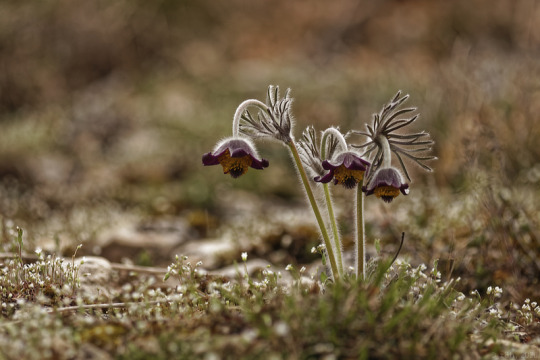
#photographers on tumblr#original photographers#small pasque flower#flowers#nature#pulsatilla pratensis#czech karst#koniklec luční#český kras
34 notes
·
View notes
Photo
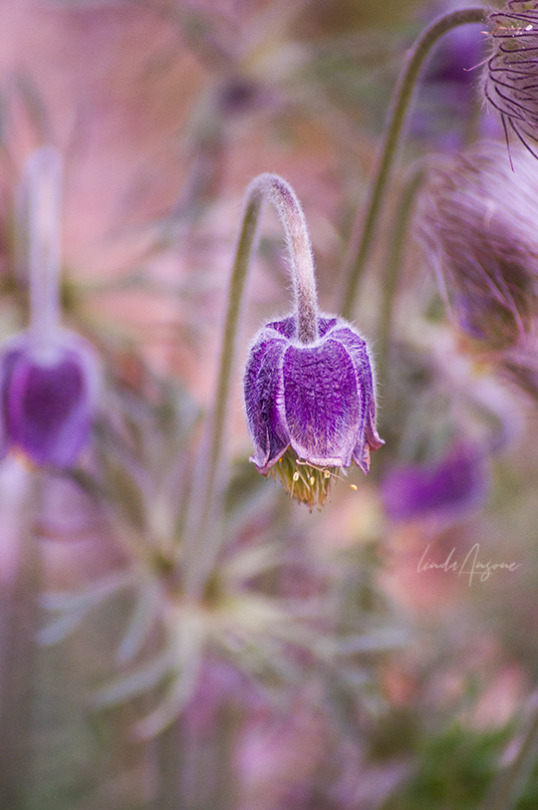



Pulsatilla pratensis
#floral#flowers#flowercore#plantcore#wild plants#pulsatilla pratensis#small pasque flower#flower photography#plants#nature#nature photography#nikon photography#original photographers#photographers on tumblr
738 notes
·
View notes
Photo

A drawing depicting white pasque flowers, made with soft pastels, on recycled paper.
E: Sold. Please take a look at my other listings on Etsy
DeviantArt
#artists on tumblr#white flowers#pasque flower#spring flowers#soft pastel#flowers#original art#shit by me#Happy Easter/Passover/Whatever you celebrate!#I'm taking a small break from making publishable art
3 notes
·
View notes
Text
planting seeds in a garden i never get to see
Was listening to Hamilton and got an idea. CW: character death
~
Halt returns to his cabin one day to find three packets of seeds on his porch. He doesn’t know where they’re from. They’re simply labeled with names: pasque flower, primrose, lily of the valley.
He looks down at the small brown packages, thinks of his sister Caitlyn. How she’d loved flowers and always wanted a garden full of them. She’s the reason he picks wildflowers and keeps them in jars around the cabin. They remind him of her. Usually, he picks them from the woods around the cabin. But now...
He takes the seed packets to a clear area near the cabin, dark brown dirt surrounded by towering green trees, roots digging deep. There’s a shovel leaning against the wall, and he takes it and begins digging some shallow holes in the ground, dropping each seed in. Caitlyn’s dead now, without her flower garden, but in honor of her, Halt will plant one.
He waters the flowers each day with a cup from the cabin and water from the river. Watches as green shoots come up. Every now and then he spreads some of Abelard’s manure around them as fertilizer. Sometimes he sits on a chair on the veranda, reading reports in the warm late afternoon sunshine. He glances up every now and then to look at the garden below him.
Slowly but surely the flowers grow, until he is sure they must be about to bloom. Each day he comes outside, eagerly awaiting the sight of blossoms. He sees the strands of lily of the valley produce the beginnings of flowers, tightly enclosed in a green calyx.
One day, when there’s not much to do, he spends the entire afternoon in the garden, kneeling in the dirt. The pasque flowers have begun to open, and he can see bright purple petals peeking out of a fluffy green and white covering. His heart swells with happiness at the sight. They are growing. When he finally stands at sunset, his back aches. Age, he thinks.
He goes inside to make dinner, happy with the day’s success. He writes a letter to Will in Seacliff. He’s told Will about the flowers, and in between gently teasing Halt about them, Will eagerly wants to know how they’re doing.
The flowers are growing well, he writes. The lily of the valley looks like it’s close to blooming. The goblets of the pasque flowers are beginning to open, and I can see purple inside. They’ll be beautiful when they arrive. I can see the primrose buds. They’re not open yet, but they will be soon.
He seals the letter, then banks the fire for the evening and walks to his bedroom in the dark. There’s not much light, even from the moon, but Halt has lived here for almost more years than he can count, and he could navigate the cabin blind.
He settles down in bed, thinking of Will and the flowers. He can’t wait to see them bloom. He’ll gather some of the blooms and put them by his bed. There will be a bundle on the kitchen windowsill, and he’ll smell their perfume as he cooks each day. He knows the lilies of the valley will smell because he’s come across their white bell-shaped flowers while out in the field. Their scent is one of his favorites.
He falls asleep like that, thinking happily of the garden he’ll have soon, the color he’ll have both outside the cabin and in it.
Halt never wakes up.
#ranger's apprentice#halt o'carrick#will treaty#cw character death#flowers#john flanagan#ra fanfic#hamilton#cass writes
34 notes
·
View notes
Link
#etsy#smallbiz#macro#photography#flower#floral#pasque flower#prints#home decor#etsy gifts#etsy finds#etsy seller#etsy shop#etsy store#shop small
1 note
·
View note
Text
16. Crane
Ankhbayar always got to work on opening his stand before the dawn.
Good boortsog took the extra time, you know. And Ankhbayar figured it deserved it.
While the cool winds of the early morning blew across the Azim Steppe, he would fold the chopped dates and nuts into the rising dough (his own touch which, he believed, elevated his above Batzorig’s paltry stand on the other end of Reunion) and sing to himself while he worked. He was Qalli, after all, and what was a Qalli without song? Besides. He liked to think that the dough appreciated his singing. Another leg up over that swindler Batzorig.
By the time Azim’s light had come to wash the fertile plains in oranges and pinks and blues, his dough had risen to its proper height. So, he stoked the fire under the stone cauldron of oil he’d inherited from his father and his father before him, and the sound of it sizzling and crackling served as the best indicator around that he was open for business.
He felt good about today. Travellers in Reunion were not uncommon, but rarely did they come in such numbers. There were about thirty different new faces around the camp, and such a tapestry of colors they were. Only one, it seemed, was a lost daughter of the Steppe, while the rest came from every walk of life Ankhbayar could imagine (and many, it seemed, he had no cause to imagine until now.)
And one of them, smallest of them all, stood in front of Ankhbayar’s stand right now.
He had not seen the girl from where he was, cutting his dough with his well loved blade into small balls, flattening them with his floured hands into uniform disks. But the soft murmur of the word “Mister” (He had tried to teach himself the tongues of those who came to Reunion, and he knew enough of Eorzean to get by in his fifty summers) had him lean past the lip of his stand.
She was a small little thing. Pink and scaleless, eyes the color of the pasque flowers that bloomed on the ridge behind him and the size of dinner plates, set in a frizzy mop of night-black hair. She was staring up at him (the small one had to crane her neck so far), and he could see how she sniffed at the smell of powdered sugar and frying dough that he knew was carried across the breeze to at least half the camp. Of course the poor thing was hungry. Her little limbs looked like matchsticks.
It was a good thing, he thought as he puffed out his chest, that she had found the stall of Ankhbayar.
“Sun’s greetings, little one.” He gave a warm smile; the kind he would give to his son’s daughters.
“G’-g’mornin’.” The girl stammered, flashing a hesitant little smile. “Yer stand smells real nice, mister... Are those treats?”
Ah, small thing. It seemed the tongue of the lands of the West sat awkwardly on her tongue, too.
“Yes they are. You will find no finer boortsog in all the lands of Othard.” Definitely not across Reunion, he added in his mind, smugly.
“W-what’s… bootsaw?” She looked sad that her tongue struggled in making the shapes. Poor little thing. Ankhbayar patiently showed her one of the disks of dough he was still smoothing between his palms.
“It is a sweet.” He said, hoping that would be enough of an explanation from his uneasy Eorzean. Some things too, he figured, were better demonstrated than explained. He gently lowered the disk into the cauldron of oil, and he tried to bite down his smile as he watched the little girl stare up at the cauldron in awe. It was probably his favorite thing about children; how wondrous the world seemed through eyes yet still big for their heads.
Once it was golden brown on one side, he flipped it with a shallow wire basket, and once the other side was finished, he rolled it in fine sugar on either side. He wrapped it loosely with a large leaf of the grape vine, and extended it down to the little one.
“This is boortsag. You take, yes?”
The little girl looked surprised, and then looked down at her feet. “B-but I don’t got anyfin ta trade…” She mumbled, and the sight of it almost broke Ankhbayar’s heart.
“No, no. Is gift, for little lady.”
His heart melted a little when he saw that smile stretch across her little pointed face, with her flat little teeth. “R-really mister? Are you sure?”
“Yes. Just tell the little lady’s family where you got the boortsog, yes?” Ankhbayar gave her a little wink, as if this was an even trade, and the girl nodded as she took the grape leaf in both hands.
“T-thank you!! Thank you so much!!” The little girl bowed her head to Ankhbayar, and giggling ran off into the hustle of the marketplace. He couldn’t help but smile as he watched her go. It was interactions like that, he mused as he got to work on rolling out another disk of dough, that reminded him why he was blessed to work at his little Reunion stall.
---------------------------------------------
His haul gathered up into a sack on his shoulder, M’khari Tia spotted Remeraux sitting on the stone fence at the edge of camp, swinging her legs in the air as she took bites out of a ring of fried dough. He hopped up next to her.
“Where’d ya get that?” He asked, and Remeraux just gave a shitty little smirk.
“Merchan’ stand. Ya won’ believe how much ye can get fer free wif the ‘little girl lost’ act.” She licked powdered sugar off of her fingers, and tore a piece off to extend his way. He chuckled, and popped it in his mouth.
“Still pullin’ that shit at nineteen?”
“Hey, fuck you!” Remeraux gave him a punch on the shoulder. “Can’ drink, can’ kiss nobody… If this is the only bleedin’ perk I get, then I’m gonna fuckin’ milk it fer every last gil.”
“Fair enough.” M’khari chuckled, as he savored the chewy fried bite of dough.
Damn, it was good, though. Were those dates?
10 notes
·
View notes